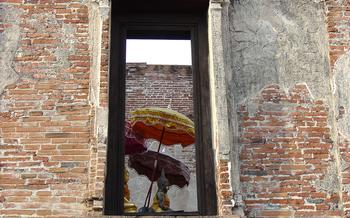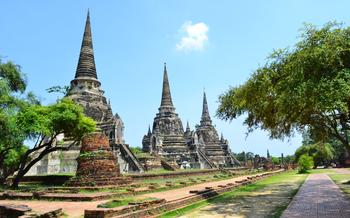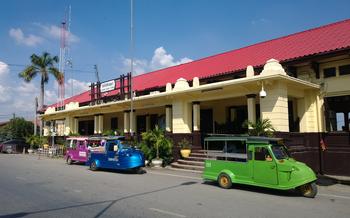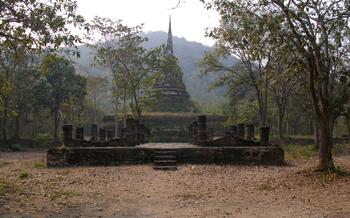
Wat Ratchaburana
- Wat Ratchaburana: A Journey Through History
- Stunning Architecture
- Spiritual Significance
- Cultural Activities
- Local Community
- Volunteer Opportunities
- Arts and Crafts
- Local Cuisine
- Accommodation and Dining
- Transportation and Accessibility
- Insider Tip: Unveiling the Temple's Hidden Chamber
Wat Ratchaburana: A Journey Through History
Wat Ratchaburana, a stunning temple located in the heart of Phitsanulok, Thailand, stands as a testament to the architectural prowess and spiritual devotion of the ancient Siamese kingdom. Its construction, commissioned by King Borommatrailokanat in the 15th century, marked a significant chapter in the city's history. The temple, designed in the Ayutthaya architectural style, exudes an aura of grandeur with its soaring spires, intricate carvings, and elegant design. Originally built as a royal monastery, it played a vital role in the religious and political life of the kingdom. Over the centuries, Wat Ratchaburana has undergone several renovations and restorations, preserving its architectural integrity while adapting to the changing times. Today, it stands as a living symbol of Thailand's rich cultural heritage, attracting visitors from around the world with its historical significance, stunning architecture, and spiritual ambiance.
Stunning Architecture
Wat Ratchaburana's architectural style is a testament to the artistry and craftsmanship of the Ayutthaya period. The temple complex is characterized by its graceful lines, intricate carvings, and decorative elements that showcase the fusion of Thai and Khmer influences. The main chedi (stupa) stands as a prominent landmark, adorned with exquisite stucco moldings, sculptures of mythical creatures, and vibrant glazed tiles. The temple's walls and pillars are adorned with delicate carvings depicting scenes from Buddhist mythology, celestial beings, and floral motifs. Each detail, from the intricate roof ornaments to the sculpted lintels, contributes to the temple's overall grandeur and reflects the deep religious symbolism inherent in its design.
Spiritual Significance
Wat Ratchaburana holds immense spiritual significance as a Buddhist pilgrimage site. Pilgrims from across Thailand and beyond flock to the temple to pay homage to the Buddha and seek blessings. The temple is believed to be particularly sacred due to its association with the relics of the Buddha, which are enshrined within the main chedi.
The temple serves as a center for religious rituals and ceremonies. Monks perform daily prayers and chanting sessions in the temple's main hall. Special ceremonies and festivals are also held throughout the year, attracting large numbers of devotees. During these events, the temple is decorated with colorful flags and flowers, and the air is filled with the sound of prayers and music.
The local community plays an integral role in maintaining the temple's spiritual significance. Laypeople often visit the temple to make offerings, pray for good fortune, or seek guidance from the monks. The temple also provides religious education and guidance to the community, helping to preserve and promote Buddhist teachings.
Cultural Activities
Wat Ratchaburana is not merely a place of worship; it also serves as a vibrant center for cultural activities that showcase the rich traditions of Phitsanulok. Throughout the year, the temple hosts a variety of events and festivals that draw both locals and visitors alike. These events provide a glimpse into the local way of life and offer opportunities for visitors to immerse themselves in the cultural heritage of the region.
One of the most significant events held at Wat Ratchaburana is the annual Kathin ceremony. This festival, which takes place during the Buddhist Lent period, celebrates the offering of new robes to the monks. During the ceremony, a grand procession carrying the robes is led through the temple grounds, accompanied by traditional music and dance performances. Visitors can witness this colorful spectacle and participate in the merit-making activities associated with the festival.
In addition to the Kathin ceremony, Wat Ratchaburana also hosts regular alms-giving ceremonies. These ceremonies, known as "tak bat," take place early in the morning as monks walk through the temple grounds, collecting food offerings from the faithful. Visitors are welcome to participate in this ritual by offering food or simply observing the serene procession of monks.
Throughout the year, the temple also organizes cultural performances and exhibitions that showcase traditional Thai arts and crafts. These events provide a platform for local artists to display their skills and share their knowledge with visitors. Visitors can enjoy traditional dance performances, music concerts, and demonstrations of traditional crafts such as wood carving, pottery, and weaving.
By participating in these cultural activities at Wat Ratchaburana, visitors can gain a deeper understanding of the local culture and traditions. These events offer a unique opportunity to immerse oneself in the vibrant spiritual and cultural life of Phitsanulok, creating lasting memories for visitors from all walks of life.
Local Community
Wat Ratchaburana is deeply intertwined with the local community of Phitsanulok, playing a significant role in its cultural and spiritual well-being. The temple serves as a gathering place for locals to celebrate religious festivals, attend ceremonies, and seek spiritual guidance from monks. The temple's monks are actively involved in community service, providing religious teachings, counseling, and assistance to those in need. Wat Ratchaburana also runs various social and charitable programs, such as providing food and shelter to the homeless, organizing medical camps, and offering educational scholarships to underprivileged students. Through these initiatives, the temple contributes to the community's social and economic development, fostering a sense of unity and compassion among its residents.
Volunteer Opportunities
Wat Ratchaburana welcomes volunteers from all over the world to contribute to the temple's upkeep and activities. Volunteers can engage in various tasks, including temple cleaning and maintenance, gardening, assisting with religious ceremonies, and teaching English to the local community. Volunteering at the temple provides a unique opportunity to immerse oneself in Thai culture, learn about Buddhism, and contribute to the preservation of a sacred site.
Volunteers are typically accommodated in simple but comfortable guesthouses near the temple and are provided with meals during their stay. The temple also offers a variety of cultural and educational programs for volunteers, including meditation classes, Thai language lessons, and guided tours of the temple complex.
To become a volunteer at Wat Ratchaburana, interested individuals should contact the temple's abbot or a designated volunteer coordinator. The temple may require volunteers to provide references and undergo a background check. The length of stay for volunteers can range from a few days to several months, depending on their availability and the temple's needs.
Volunteering at Wat Ratchaburana is a rewarding experience that allows individuals to make a positive impact on the temple and the local community. It is an opportunity to learn about Thai culture, engage with the local people, and contribute to the preservation of a sacred Buddhist site.
Arts and Crafts
Wat Ratchaburana is renowned for its exquisite traditional arts and crafts, which play a vital role in preserving and promoting the cultural heritage of the temple and the local community. The temple's skilled artisans create intricate carvings, sculptures, and paintings that adorn the temple's interior and exterior. These artworks depict religious scenes, mythical creatures, and floral motifs, showcasing the temple's rich artistic and spiritual traditions.
The artisans use various techniques and materials, including woodcarving, stone carving, and painting. They employ traditional tools and methods passed down through generations to create intricate designs and lifelike representations. The resulting artworks are not only aesthetically pleasing but also carry deep symbolic and religious significance.
The temple's arts and crafts are not merely decorative but also serve a functional purpose. Carved wooden doors and panels, for example, not only enhance the temple's beauty but also provide privacy and protection. Intricate murals adorn the temple's walls, narrating stories from the Buddha's life and teachings, serving as a source of inspiration and guidance for devotees.
Visitors to Wat Ratchaburana have the opportunity to witness the artisans at work and learn about the techniques and processes involved in creating these beautiful artworks. The temple also offers workshops and demonstrations, allowing visitors to try their hand at traditional crafts and create their own unique souvenirs.
By supporting the artisans and their crafts, visitors contribute to the preservation of Thailand's rich cultural heritage and help ensure that these traditional skills continue to be passed down to future generations.
Local Cuisine
Wat Ratchaburana is not directly associated with any specific local dishes or delicacies. However, the temple is located in the Phitsanulok province, which has a rich and diverse culinary heritage. Visitors to the temple can explore the local markets and restaurants to sample an array of traditional Thai dishes and regional specialties.
Some of the must-try dishes in Phitsanulok include nam tok, a spicy grilled pork salad; gaeng som, a sour and spicy fish curry; and khao soi, a northern Thai noodle soup. These dishes are widely available at local restaurants and street food stalls, allowing visitors to indulge in the local flavors while exploring the city.
For a unique dining experience, visitors can head to the night market near the Yom River. Here, they can find a variety of food stalls selling local delicacies, such as grilled meats, seafood, and tropical fruits. The night market is a vibrant and lively place to sample the local cuisine and soak up the atmosphere of Phitsanulok.
Accommodation and Dining
When planning your visit to Wat Ratchaburana, you'll find a range of accommodation options to suit your preferences and budget. Numerous hotels and guesthouses are located within walking distance of the temple, offering comfortable stays with modern amenities. For a more immersive experience, consider traditional homestays, where you can interact with local families and gain insights into their way of life.
For dining options, the area surrounding the temple offers a delectable array of local and international cuisine. Savor authentic Thai dishes at nearby restaurants, where you can indulge in aromatic curries, spicy salads, and mouthwatering noodle soups. If you're looking for a quick bite, street vendors offer a variety of snacks and treats, including grilled meats, fresh fruits, and sweet desserts.
To make the most of your time in Phitsanulok, consider combining your visit to Wat Ratchaburana with other attractions in the city. Explore the majestic Wat Phra Sri Rattana Mahathat, marvel at the stunning murals of Wat Yai, or immerse yourself in the natural beauty of Phu Hin Rong Kla National Park. With its rich cultural heritage and diverse attractions, Phitsanulok offers an unforgettable travel experience.
Transportation and Accessibility
Getting to Wat Ratchaburana from Phitsanulok city center is a breeze, with several convenient transportation options available. For a budget-friendly option, hop on one of the many local buses that ply the route between the city center and the temple. These buses are easily recognizable by their blue and white livery and typically depart from the main bus station. Alternatively, you can hail a tuk-tuk, a three-wheeled motorized rickshaw, for a more personalized and immersive experience. Tuk-tuks are readily available throughout the city and can be negotiated for a reasonable fare.
If you prefer the comfort and convenience of a private vehicle, taxis are widely available and can be hired for a day trip to the temple. Several car rental agencies in the city offer self-drive options for those who wish to explore the region at their own pace.
Once you arrive at Wat Ratchaburana, ample parking space is available within the temple grounds. Visitors with limited mobility can request assistance from the temple staff, who are always ready to lend a helping hand. The temple's pathways are generally well-maintained and accessible for wheelchairs and strollers.
Insider Tip: Unveiling the Temple's Hidden Chamber
As I wandered through the serene grounds of Wat Ratchaburana, a local monk approached me with a knowing smile. He whispered of a hidden chamber beneath the main chedi, accessible only to those who sought a deeper connection with the temple's spiritual essence. Intrigued, I followed him through a discreet doorway, descending a narrow staircase that led to a dimly lit chamber.
There, in the flickering candlelight, I discovered a mesmerizing sight: a collection of ancient Buddhist relics, intricately carved statues, and sacred texts that had been carefully preserved for centuries. The monk explained that this hidden chamber was once used for meditation and spiritual retreats by the temple's most devoted monks. Its existence was kept secret to protect the sacred artifacts from potential harm or desecration.
Visiting this hidden chamber was a truly humbling and awe-inspiring experience. It felt like a privilege to be granted access to such a sacred and secluded space, where the temple's rich history and spiritual essence were tangible and palpable. It reminded me that there's always more to discover beyond the surface, and that sometimes, the most rewarding experiences are those that are hidden from plain sight.






